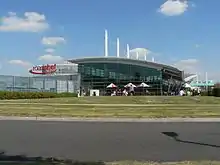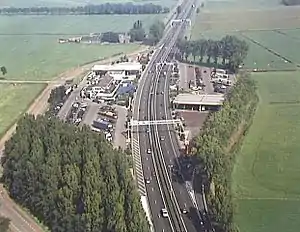Motorway service area
Motorway service areas in the United Kingdom and Ireland, also known as 'service stations' or 'services', are places where drivers can leave a motorway to refuel/recharge, rest, eat and drink, shop or stay in an on-site overnight hotel. The vast majority of motorway services in the UK are owned by one of three companies: Moto, Welcome Break and Roadchef. Smaller operators include Extra, Westmorland and EuroGarages.

History

The first service area in the UK was at Watford Gap on the M1, which opened with the motorway on 2 November 1959.[1] As more service stations opened, the number of operating companies increased, such as Blue Boar, Kenning Motor Group, Pavilion, Take a Break and Esso. Through acquisitions and mergers there are now only three major operators. In an attempt to break this oligopoly, the government proposed allowing "mobile fast food vans" to operate at the areas,[2] though this idea has not come about.
Originally, service areas were government owned and leased to the operating companies. From 1992 onwards, new sites were planned and owned by private operators, and existing sites sold to them.
In 2007 an AA survey concluded that service areas had improved in the previous three years, but cleanliness and pricing were still major issues.[3]
Opposition towards service areas has grown, with some planning applications being refused: some notable examples are Catherine-de-Barnes on the M42[4] and Kirby Hill on the A1(M),[5] both of which have had applications refused. Despite concerns of local residents,[6] Beaconsfield on the M40 opened on 17 March 2009,[7] and Cobham services opened in September 2012.[8]
UK MSA Operators
By Number of Locations:
- Moto Hospitality - 45 UK MSA sites
- Welcome Break - 44 UK MSA sites (purchased by Applegreen in 2018 for £361.8m)
- Roadchef - 30 UK MSA sites
- Extra (service areas) - 9 UK MSA sites
- Applegreen UK - 2 UK MSA sites
Locations

Current government policy is that the interval between core motorway service areas should be no more than 28 miles or 30 minutes travelling time, whichever is the lesser.[9] A previous minimum separation of 12 miles[10] was removed in 2013. The current 28 miles is derived from 30 minutes driving time for an HGV limited to 56 mph and replaced the previous 30 miles in 2008.[10]
Initially service areas were located between junctions (on-line sites), having their own entry and exit slip roads. On-line sites usually have a separate site for each direction of travel, but e.g. Cobham services has a single site, accessed directly from the clockwise carriageway and via a tunnel from the anticlockwise carriageway of the M25.
In 1992, the system was changed so that the developer became responsible for choosing the site of a motorway service area, and consequently junction sites became the preferred option as they are cheaper to construct, as well as being accessible to traffic travelling in several directions. Following a public consultation in 2007/8, the Department for Transport/Highways Agency announced that new services should be located at on-line sites, unless a junction site is the only possibility.[10]
Two of the most recent openings, Wetherby (2008) and Beaconsfield (2009), are examples of junction sites: they are located at A1(M) junction 46, and M40 junction 2 respectively. However, more recently still, Cobham (2012) and Gloucester (2014) are on-line.
The siting of motorway service areas can be contentious, leading to protracted public inquiries, and often vociferous local campaigns against proposed schemes.[11]
Pricing
The operating company must pay the full cost of constructing the entry and exit slip roads, signage, and all other features required for safe access to motorway services, as well as the motorway services facility itself. In other countries, the authority responsible for the highway tends to subsidise these costs on the grounds that these areas are partly a public service to drivers. The leases provide that motorway services must operate 24 hours a day, and the costs of providing utilities and services are high.[12] With very few customers in the early morning, they need to earn the money in other ways.
Facilities and requirements
Government policy for motorway services has been set out in a succession of Department for Transport Circulars, the current version being 2013.[9] This sets out various facilities that must be provided in a new service station. Existing services that do not comply, because the requirements have changed, must achieve compliance as part of any significant refurbishment. These are enforced on operators either by the terms of their lease or by the need for the Highways Agency to agree to provide access to the motorway, and planning permission should be granted only for facilities that comply. The requirements include 24-hour, 365-day provision of:
- Free parking for a minimum of 2 hours. Separate parking must be provided for motorcycles, cars, caravans (drive-through so as not to require reversing), coaches, HGVs, abnormal loads, and disabled parking. In each case the minimum number of spaces is set by a formula based on traffic flow.
- Fuel.
- Free toilets and hand-washing facilities with no obligation to make a purchase. The minimum number of toilets is specified by a similar formula to that for parking. Shower and toilet facilities are also required within the HGV parking area.
- Baby-changing and breastfeeding facilities.
- Free play area for children.
- Hot drinks and hot food. Until 2013, the requirement was only for 24-hour snacks and hot drinks, plus hot substantial food from 6 am to 10 pm.[10]
A picnic area with a minimum of 10 tables each seating 6 people was required up to 2013,[10] and is still required in order for a picnic area to be advertised on signage.
The following restrictions also apply:
- All traffic signing must comply with the Traffic Signs Regulations and General Directions that specify traffic signs for the rest of the road network.
- Rear access, from the local road network, is either not provided at all, or is restricted to staff and deliveries and is physically segregated from the main service area.
Lodges for accommodation are permitted. Conference facilities or business centres and retail space are permitted; the size of each of these was limited, basically to 200 m2 and 500 m2 respectively, until 2013, but are now left to the planning system.
Originally, service areas were allowed to sell alcohol with food. Sale of alcohol was outlawed on service areas on government-owned land from 1961, permitted from 1998, banned for new sites from 2008, and permitted again from 2013.[13]
The government policy distinguishes "service areas" and "rest areas". There are 3 rest areas (Todhills, Leeming Bar, and Scotch Corner). All were existing facilities on trunk roads that were upgraded to motorways, and now, in fact, meet the requirements for service areas.[14] There is a further category of Truck Stop, serving HGVs only.
Ireland
Ireland has four motorway service areas – initially the National Roads Authority opposed them on the grounds that it preferred to see traffic using existing businesses in bypassed towns, and that the motorway network was not large enough for them anyway.[15] However, in 2006 it changed its mind, and the Roads Act 2007 makes provision for a Motorway Service Area Scheme to be made for proposed motorway service areas. The NRA held a competition to determine an operator for the first round of service areas to be opened.[16] Superstop, a consortium consisting of Petrogas (Applegreen) and Tedcastles Oil Products (TOP), won the contract.[17] The first service area, Lusk services, opened on the M1 on 8 September 2010. Castlebellingham services (also on the M1) opened on 29 September 2010, with Enfield services on the M4 opening shortly after in late 2010. The fourth service area, Wicklow services station (J14, M11) opened on 29 May 2014. While other locations for service areas were planned by the NRA, they are unlikely to proceed in the short term due to the economic recession. "No services on motorway" signs have been erected on the M7, M8, and M9. The NRA has stated that it now intends to erect signs to petrol stations off the motorway instead.
See also
References
- "Motorway Services Trivia – M1 Watford Gap". Msatrivia.co.uk. Archived from the original on 28 February 2009. Retrieved 23 March 2009.
- Bamber, David (19 June 2001). "Burger vans to sell fast food at M-way services". The Daily Telegraph. London. p. 1. Retrieved 5 May 2009.
- "Public Affairs : UK motorway service areas improve but at a price". The AA. 11 July 2007. Retrieved 23 March 2009.
- "Catney Residents Association – Motorway Service Area". Catney.co.uk. Archived from the original on 28 March 2009. Retrieved 23 March 2009.
- "www.kirbyhill.org". kirbyhill.org. Retrieved 23 March 2009.
- "New MSA could bring Handy Cross-style traffic chaos in Beaconsfield". Bucksfreepress.co.uk. 12 November 2006. Retrieved 23 March 2009.
- "Beaconsfield Motorway Service Area to open tomorrow". Thisislocallondon.co.uk. 16 March 2009. Retrieved 23 March 2009.
- "Cobham M25 service station opened". BBC News. 13 September 2012. Retrieved 13 September 2012.
- "The Strategic Road Network and the Delivery of Sustainable Development". Department for Transport Circular 02/2013, 10 September 2013. Available at "https://assets.publishing.service.gov.uk/government/uploads/system/uploads/attachment_data/file/237412/dft-circular-strategic-road.pdf
- Policy on Service Areas and Other Roadside Facilities On Motorways and All-Purpose Trunk Roads in England Archived 22 November 2010 at the Wayback Machine – the Department for Transport
- Mcclymont, Katie; O'Hare, Paul (1 June 2008). ""We're not NIMBYs!" Contrasting local protest groups with idealised conceptions of sustainable communities" (PDF). Local Environment. 13 (4): 321–335. doi:10.1080/13549830701803273. ISSN 1354-9839.
- "Why the Prices?". Motorway Services Online. Retrieved 22 March 2009.
- "Alcohol at motorway services". Motorway Services Online. Retrieved 14 November 2019.
- "Rest area – motorway services". Motorway Services Online. Retrieved 16 November 2019.
- "Cullen in call to NRA on service stations". RTÉ News. 15 June 2005.
- "News Announcements – National Roads Authority". Nra.ie. Retrieved 23 March 2009.
- http://www.nra.ie/News/PressReleases/htmltext,16697,en.html
External links
| Wikimedia Commons has media related to Motorway service areas in the United Kingdom. |
